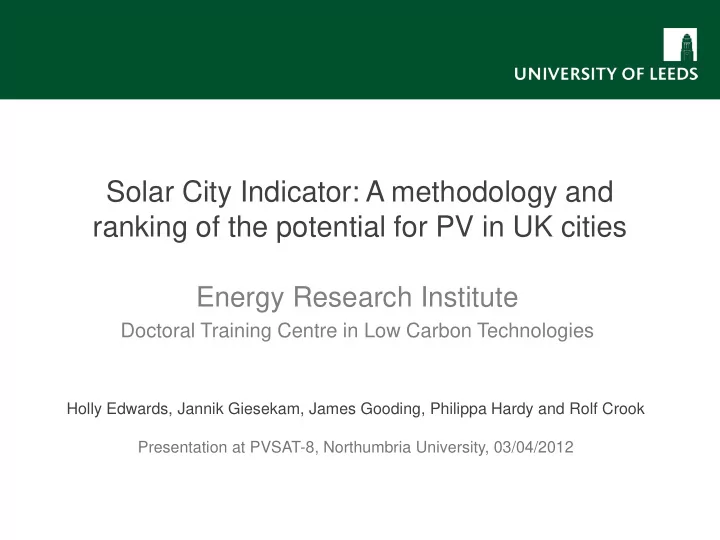

Solar City Indicator: A methodology and ranking of the potential for PV in UK cities Energy Research Institute Doctoral Training Centre in Low Carbon Technologies Holly Edwards, Jannik Giesekam, James Gooding, Philippa Hardy and Rolf Crook Presentation at PVSAT-8, Northumbria University, 03/04/2012
Introduction • Aims & Rationale • The Solar City Indicator • Physical Capabilities • Socio-economic Considerations • Solar City Indicator Results • Scenario Results • Conclusion
Aims and Rationale • To create a Solar City Indicator, which will demonstrate the potential for solar PV installation within a city, taking into account: • Physical capability Dundee • Socio-economic influences Glasgow Edinburgh • To compare the outcome across a selection of geographically distributed cities • To assess the impacts of changes to • FiT Sheffield • Cost of Panels Nottingham Derby • Cost of Electricity Leicester • Payback • Changes to socio-economic factors
Solar City Indicator Analysis undertaken to calculate the Solar City Indicator included the following: • Physical Analysis – Annual solar irradiance at each building in a city • Latitude • Orientation • Slope of roof – Topological and surrounding building shading effects – Weather effects • Socio-economic Analysis – Ability to install solar PV • Tenure • Housing stock (and income for new FiT rates) – Desire to install solar PV • Education • Environmental consciousness
Recent Growth in Solar PV • 242,000 new installations since start of June 2011 • 870 MW of additional capacity (now past 1GW total)
Assessing Physical Capability IMBY http://www.nrel.gov/eis/imby/ SUN-AREA http://www.sun-area.net/ SEES http://www.gvc.gu.se/Forskning/klimat/stadsklimat/gucg/software/sees/ P. Asinari and L. Bergamasco (Turin 2011)
Methodology Split buildings layer Assign building into two layers for Source data from class values to larger properties Landmap building polygons and smaller properties (<200m 2 ) Reduce Digital Surface Compute insolation Analyse slopes and Model to building using Area Solar aspect of roofs footprints Radiation Tools Evaluate total Overlay aspect, Export attribute insolation for each slope and insolation table to excel and property’s suitable layers to produce process using area and assign to suitable areas custom macro attribute table
Methodology
Small Properties Roof Slope per BC 45 40 35 30 Degrees 25 20 15 10 5 0 (25) DNU 26 (27) DNU 28 29 30
Physical Results
Socio-economic Factors 1. Desire Factors Education - % of adult population with a minimum qualification of level 4/5 Environmental Consciousness - % household waste recycled 2. Ability Factors Tenure - % of households owned Housing Stock - % houses/bungalows Income - average income employed/retired population (Depending on FiT Level)
Socio-economic Factors
Socio-economic Scenarios
Overall Results
Scenarios Series of scenarios considered changes in: • FiT Rates • Electricity Prices • Acceptable Payback Period • Price of Panels
Cost of Panels Reduces • A 40% decrease in the cost of panels would result in a 136% increase in total viable output and would make 73% of large properties viable (baseline = 14.3%)
Feed-in Tariff Changes • New UK tariffs result in a 98% reduction in total viable output and leave less than 1% of large properties viable
Further Work • Physical Capability – Improvements for small property estimations – More accurate representation of unusual roofs – Automated ‘cleaning’ process for building polygons – Ultimately limited by data availability and low resolution of LiDAR data • Socio-economic Influences – Underpin factor choice with more qualitative research into what determines uptake levels. – Design a methodology that more effectively incorporates uptake among businesses into account.
Conclusions • A method for assessing a city’s potential to install solar PV has been demonstrated • A North/South divide is not as clear as might be preconceived • Socio-economic factors have a strong influence on likely uptake • Viability is highly dependent on price of panels, which are expected to keep falling • New FiT will have a significant impact on a growing PV industry
Thank you Contact: Holly Edwards pmhae@leeds.ac.uk
Recommend
More recommend